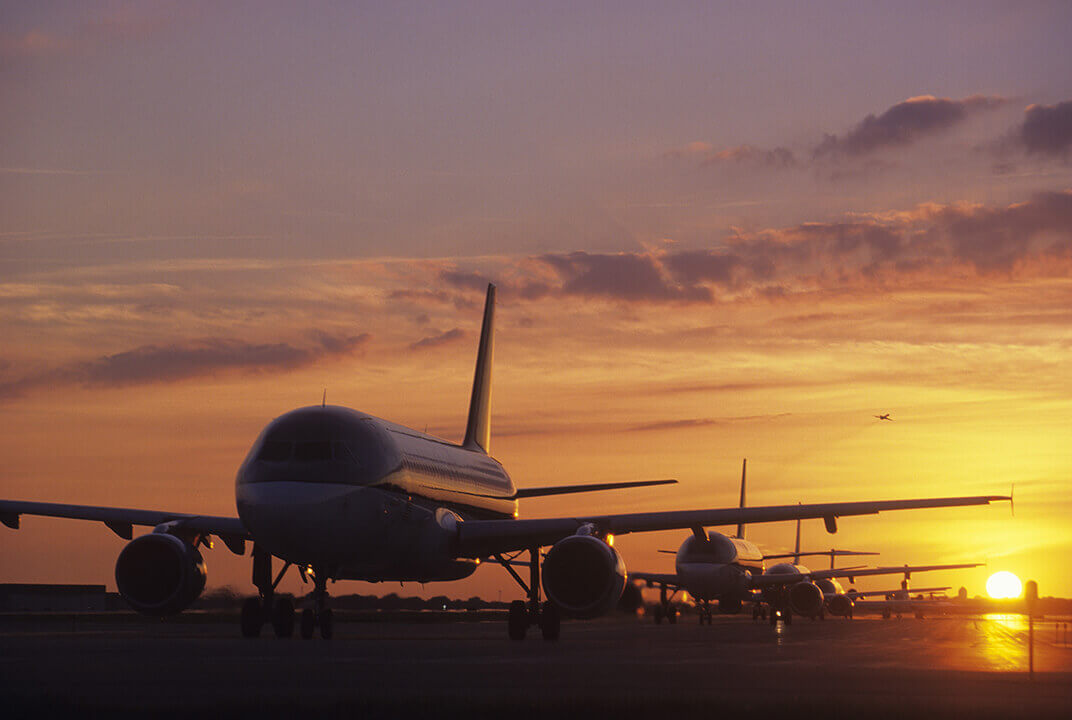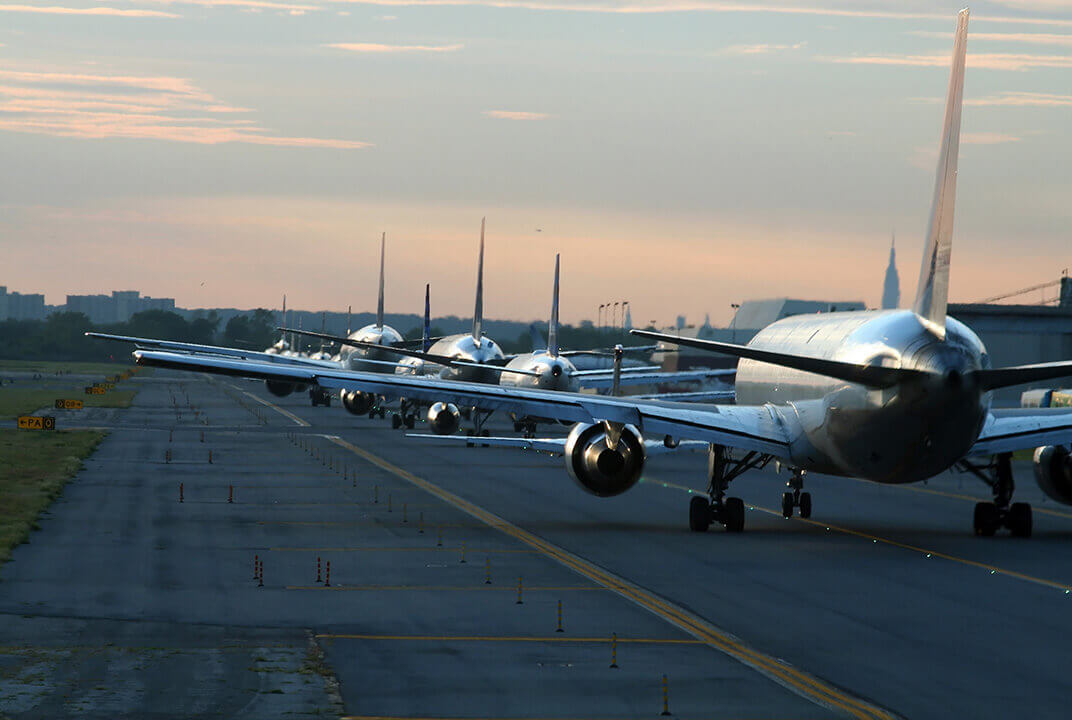Insight | The future of connected airline operations
Select Language
The future of connected airline operations
Aviation
Three experts reveal why providing advanced inflight broadband communications to the flight deck will bring economic benefits for airlines.
While most of the attention regarding the introduction of high-speed onboard Wi-Fi has focused on the cabin experience, less has been said about connectivity’s wider implications for the airline industry. Yet secure IP connectivity will transform operational efficiency, while enabling new concepts of safety. Many experts agree that we’re on the cusp of a revolution, driven by the ongoing digitalisation of airlines.
It’s going to be a similar step change to when we first put satellites into aviation 25 years ago,” says Captain Mary McMillan, Inmarsat’s Vice President of Aviation Safety and Operational Services.
“IP connectivity is the big game changer in town,” agrees Tony Spouncer, Senior Director of Global Safety and Operational Services at Inmarsat.
And Dr Alexander Grous of the London School of Economics - author of the Sky High Economics report on the commercial benefits of connected airline operations - says the economic case is clear: “At the moment, the industry experiences delays and costs that in many cases can be either entirely prevented or minimised. And the enabler will be the use of advanced broadband comms to the cockpit and cabin.”
So where will these efficiencies come from and how will a connected airline be different from those operating today?
Optimising flows for fuel savings
Cockpit connectivity is a crucial component in developing a satellite-based communication system for air traffic management. The Iris Programme currently being built by the European Space Agency aims to enable 4D trajectory- based operations in the future.
“It will allow us to determine an aircraft’s flightpath before it has taken off, using a prescribed path that’s determined not just by lateral and vertical components but also by time,” says Captain McMillan. “If we can actually hit the waypoints within plus or minus two seconds and we have a lot of certainty about other aircraft in the area adhering to that same level of flight planning, then we can safely and confidently put more aircraft into the same available airspace.”
In other words, the statutory separation distances between planes in the air can be reduced, meaning more planes can fly in less airspace, and flow management can be optimised, leading to fewer delays. Ascents and descents can also be managed more smoothly, resulting in fuel savings.
All the data, all the time
IP connectivity means that data isn’t just downloaded to the cockpit while the plane is on the ground, but at any time during a flight. And vice versa, the cockpit also transmits data. In fact, the average B787 generates a half terabyte of data per flight. As Spouncer puts it, “An aircraft is like a giant flying USB stick that happens to have people on it.” Imagine if all that inflight data could reach airline operations centres in real-time.
The implications of this are huge. Take the monitoring of a plane’s engines and airframe, for example. Currently thousands of different parameters can be measured every few seconds during a flight. The A380 has around 6,000 sensors across the plane that capture every detail of its operation.
Before real-time connectivity, data was stored on a server and was examined once the plane has landed. Now, if a problem is detected and a new part may be required, this can be readied and pre-positioned for when the plane lands, thus minimising costly delays. In extreme situations, if a new part is not available in the destination airport, this could even result in a plane being diverted to another airport where the part is available – the short-term disruption resulting in a longer-term gain.
And it’s not just mission-critical equipment that can be monitored, but also cabin service items. Sensors on an oven or lavatory, for instance, can alert the ground that a part is dysfunctional, so it can be more quickly replaced, avoiding impacts to passenger experience or even delays from grounding the aircraft.
Real-time data from the plane isn’t just applied to maintenance and repair operations to generate cost efficiencies, it also creates an opportunity to enable new concepts of flight safety. The connected aircraft will be able to stream flight data to a virtual Black Box In The Cloud™. Should a plane behave abnormally, such as veer off course or ascend or descend too rapidly, the system can automatically elect to stream all flight data to the ground instantly.
“Flight tracking tells us where the flight is, flight data streaming tells us what’s happening,” said Captain McMillan, “and this kind of flight data streaming can only happen with a high-speed, secure IP connection.”
“This is why IP connectivity is a game changer,” says Spouncer. “You can now look at every aircraft as it’s flying, see where it is, talk to it, process its data, send it data, or it will spit data out if it’s got a problem.”
Beating the weather
Bad weather doesn’t just cause delays, it can also cause injuries to passengers and crew and increase airframe wear and tear. Dr Grous says that a large airline can experience between 300 and 400 injuries a year caused by turbulence, meaning passenger and crew discomfort and potentially high compensation costs.
The fuel-savings opportunities are also significant. As we know, flying through bad weather – such as strong headwinds – uses more fuel than flying in stable conditions. With real-time graphical weather displays on a pilot’s electronic flight bag (EFB) in the cockpit, pilots can implement better advance decision-making and coordinate flight route changes with the AOC and ATC to choose the best, least fuel-consuming path.
At present, once a plane is airborne, it relies on its onboard weather radar to identify and avoid areas of convective weather, and that radar can only see around 100 miles ahead. “Once you’re airborne,” says Captain McMillan, “you’re kind of picking your way through the weather.”
But with broadband in the cockpit, satellite and radar images are immediately available in real-time, allowing pilots to see weather systems far ahead. “So for example they can work out that instead of making a left hand turn to avoid weather directly in front of them, they’ll be much better off taking a right hand turn to avoid a larger cell 500 miles ahead of them,” says Captain McMillan, who recalls a recent occasion when IP-connected Hawaiian Airlines planes flying across the Pacific were able to avoid a potentially damaging weather system, while planes from other airlines flew straight into it.
And because pilots will be able to communicate with both the ground and other pilots using ‘voice over IP’ (VOIP) technology, those who encounter other hazards in the air, such as volcanic ash, which isn’t picked up by radar, can easily warn air traffic control and other aircraft.
IP connectivity in the cockpit also allows the airline on the ground to make minor changes to a plane’s flight management system en route, like changing the flight plan to take advantage of more favourable wind at a different altitude.
Security will also improve. Pilots currently communicate with ground teams using VHF transmissions, but these are not private and can be intercepted on the ground. VOIP calls, however, will be hosted on a private VPN, and will therefore remain private. This is just one area in which security will be enhanced. “A lot of work is going into cockpit security,” says Spouncer. “It needs to be military grade.”
Telemedicine becomes possible
Flight diversions caused by illness on board can be a major cause of disruption for airlines. According to Dr Grous, a large airline can experience between 100 and 200 diversions a year and according to Captain McMillan, 80% of medical diversions turn out to have been unnecessary.
The ability to treat sick passengers during a flight is currently extremely limited. But inflight connectivity offers a host of possibilities in terms of both assessing sick passengers and giving them treatment. For instance, readings from onboard medical equipment can be transmitted to a doctor on the ground, or a video call can be used to help allow a doctor to make a judgement on a patient’s condition.
Reduced turnaround times
And there are other, less obvious, advantages too. For the crew of a fully connected plane, for example, life changes from the moment they arrive at the airport. Now there’s no need to print out paperwork, including a flight plan, weather reports, crew rosters and so on. Instead, they can head straight to the plane, where all this information is downloaded on to an EFB.
Similarly, on landing at a destination, the ability to complete the digital ‘paperwork’ on board the aircraft reduces the turnaround window. This is particularly beneficial to low cost carriers who might be completing many turnarounds a day.
These are just some of the airline operations advantages brought about by the introduction of secure broadband to the connected aircraft. While on the face of it, some of the operational applications might seem like small changes, together they can add up to huge incremental efficiency gains. And as more data is generated and analysed, it’s likely that new operational applications will emerge.
Asked if he’d had any surprises while doing his research into the commercial aspects of onboard connectivity, Dr Grous says one of the biggest insights was the lack of current awareness from many airlines of the technologies that could help them both become more efficient and also increase safety. As he puts it, “Some of these technologies are not that difficult to adopt.“
And our skies will only get busier – IATA forecasts that global passenger numbers will double by 2036. To meet this growing demand, and the resulting flight ops requirements, it’s clear that the fully connected airline offers a host of additional advantages that will drive growth and profitability, improve efficiency and enhance safety for all.


